US Cannot Meet Its Paris Commitments Through Energy Alone

Table of Contents
Author(s)
Share this Publication
- Print This Publication
- Cite This Publication Copy Citation
Mark Finley, "US Cannot Meet Its Paris Commitments Through Energy Alone" (Houston: Rice University's Baker Institute for Public Policy, November 17, 2023), https://doi.org/10.25613/TS42-P009.
Overview
The U.S. has made substantial progress in reducing its greenhouse gas emissions since 2005 — the base year for international commitments under the Paris Agreement. Carbon dioxide emissions from the combustion of fossil fuels have accounted for the largest share of U.S. greenhouse gas emissions, as well as the largest share of reductions to date.
Now, the initial Paris Agreement target date of 2025 is looming. This report examines changes in the U.S. energy system that have driven the large reduction in CO2 emissions since 2005 and the challenges the U.S. faces in trying to meet its initial greenhouse gas reduction target through energy alone.
Introduction
Twenty years ago, parties to the United Nations Framework Convention on Climate Change (UNFCC), including the United States, agreed to share their national plans for addressing climate change.[1] These plans became the commitments each participating country volunteered for under the Paris Agreement, which went into effect in 2016.[2]
The U.S. submitted its national target, or “nationally determined contribution” (NDC), in 2015. It initially committed to reduce net greenhouse gas (GHG) emissions by 26–28% below 2005 levels by 2025.[3] Since then, it has updated its NDC; after withdrawing from the Paris Agreement in 2020, the U.S. rejoined the accord in 2021 and renewed its 2025 commitment, now extending the time frame with an intended net GHG emissions reduction of 50–52% by 2030.[4] The U.S. Environmental Protection Agency (EPA)’s latest annual “Inventory of U.S. Greenhouse Gas Emissions and Sinks” reports that, as of 2021, U.S. net GHG emissions had fallen by 16.6% since 2005, and that CO2 emissions had fallen by 17.9%.[5]
With the 2023 United Nations Climate Change Conference about to begin in the United Arab Emirates on Nov. 30, this report sets out to examine the role of CO2 emissions from the combustion of fossil fuels in overall U.S. GHG emissions; assess the changes in the U.S. energy system that have driven the large reduction in CO2 emissions since 2005; and briefly discuss additional reductions needed to reach the country’s 2025 target.[6]
In light of recent U.S. legislation — such as the 2022 Inflation Reduction Act and the 2021 Infrastructure Investment and Jobs Act — the impact of which will build over time, this report does not address the prospect for more material changes to the U.S. energy system and U.S. GHG emissions beyond 2025.
Trends in Emissions and the Central Role of Energy
According to the latest EPA inventory, gross U.S. GHG emissions in 2021 were equivalent to 6,340 million metric tons of CO2 (MMT CO2e).[7] Of that, CO2 was by far the largest contributor, accounting for 5,032 MMT CO2e, or 79% of gross emissions.[8] The EPA further reports that the energy sector accounted for the vast majority (96.5%) of U.S. CO2 emissions.
The U.S. Paris target is based on net emissions, which also account for removal of CO2 from the atmosphere due to changes in land use, including forests and other carbon “sinks”, which reduced gross emissions by about 13% in 2021, resulting in net GHG emissions of 5,586 MMT CO2e.
Figure 1 — US Greenhouse Gas Emissions, 1990–2021
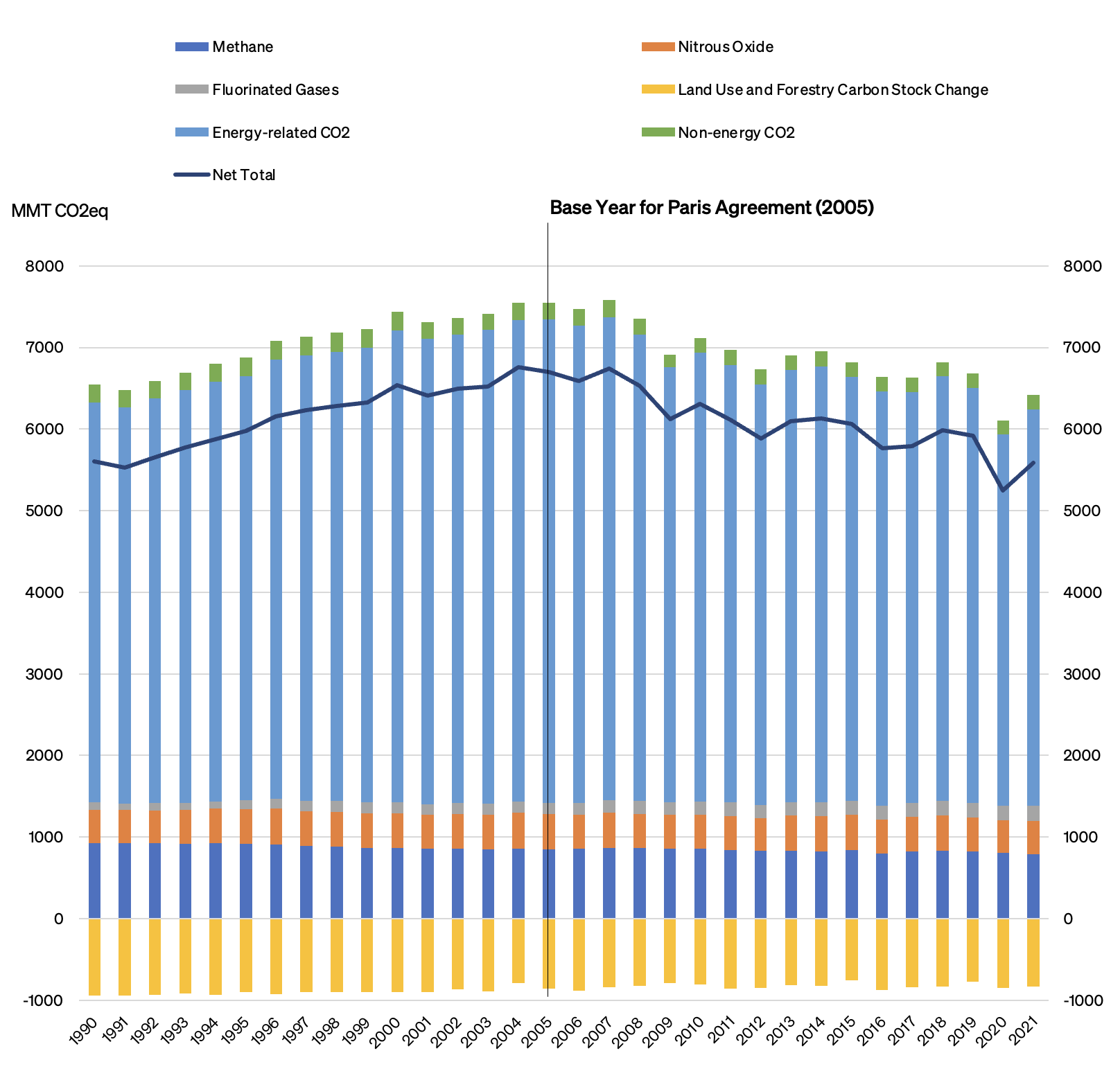
The EPA inventory shows that transport has become the largest sector responsible for U.S. GHG emissions, accounting for 28% of gross emissions in 2021. That year, it was followed by the power generation, industry, agriculture, and combined residential and commercial sectors (25%, 23%, 10%, and 13%, respectively).
Figure 2 — Gross US Greenhouse Gas Emissions, 1990–2021
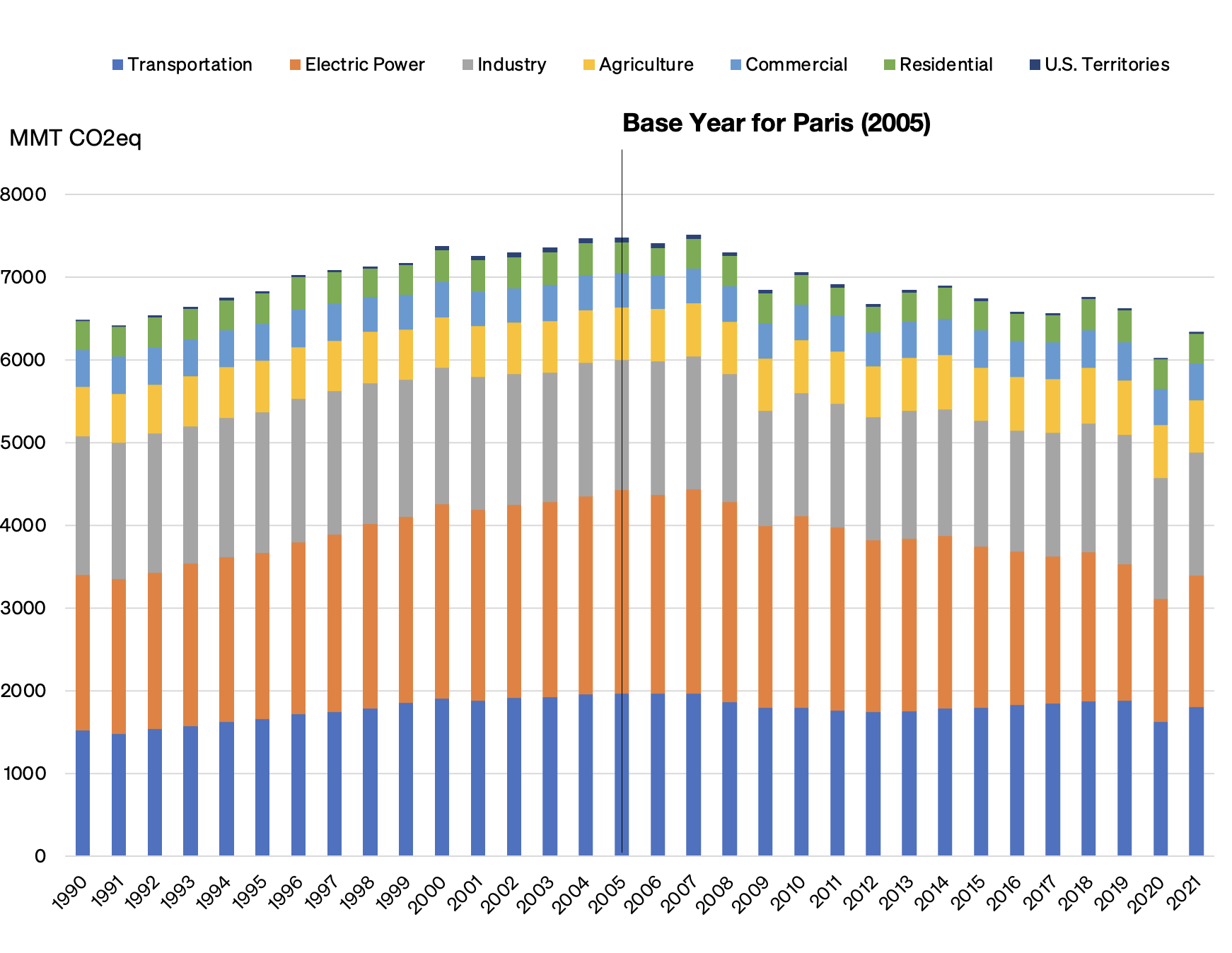
Note: Gross emissions exclude carbon sinks.
The EPA inventory shows that net GHG emissions fell by 16.6% between 2005 and 2021, with CO2 emissions (which fell by 17.9%) accounting for the nearly all (more than 99%) of the decline. Excluding energy-related CO2 emissions, all other net GHG emissions fell by just 5%, or just 3% of the total decline. Gross GHG emissions have fallen in each of the three leading sectors, with the power sector seeing by far the largest drop (36%). Even though transport emissions have fallen by 8%, transport emissions surpassed those of power generation in 2017. Since then, the gap has continued to widen.
Figure 3 — Changes in US Greenhouse Gas Emissions, 2005–21
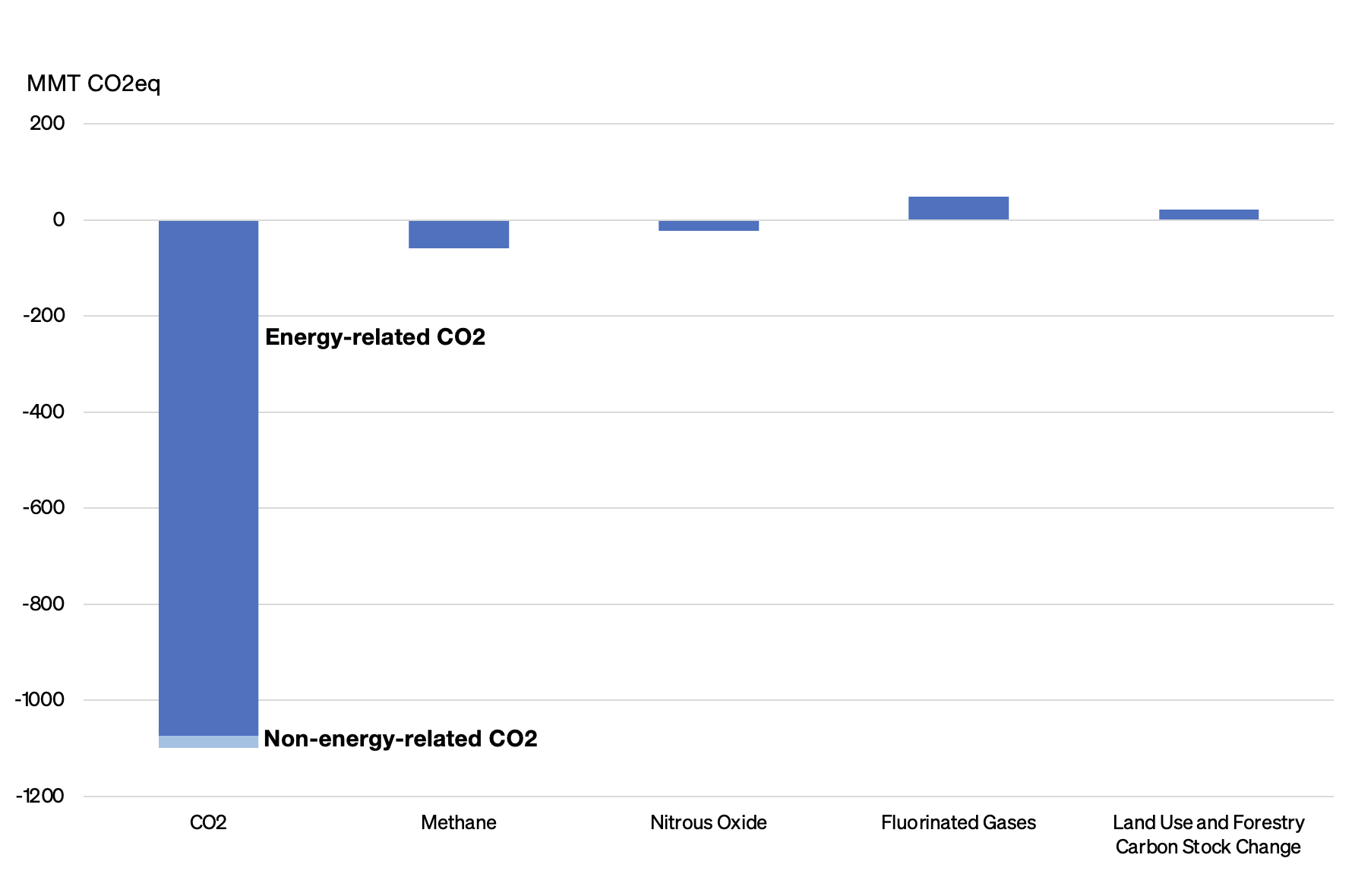
While the EPA inventory has not yet been updated with 2022 data, the U.S. Energy Information Administration (EIA) does report 2022 data for domestic energy consumption and related CO2 emissions.[9] The EIA reports that CO2 emissions from fossil energy consumption rose by 0.7% in 2022, with a large increase in emissions from natural gas combustion and a small increase in petroleum-related emissions (5.3% and 0.7%, respectively) offsetting another large decline of 6.8% in coal-related emissions.
Changes in US Energy Demand Have Driven Overall US GHG Emissions Reductions
As mentioned above, domestic energy demand accounts for the heavy majority of U.S. GHG emissions. Moreover, it has accounted for virtually all of the decline in U.S. emissions since 2005. Note that the following discussion will rely on EIA data, given our focus on the energy sector.
EIA data shows that CO2 emissions from energy use were 6007 MMT in 2005, peaked at 6016 MMT in 2007, and trended lower before collapsing along with energy demand during the COVID-19 pandemic, later recovering in 2021–22. EIA data shows that U.S. energy-related CO2 emissions in 2022 were 18% below 2005 levels.[10] In comparison, emissions for the 15 years leading up to 2005 rose by 19%.
Figure 4 — US Energy-Related CO2 Emissions by Fuel, 1973–2022
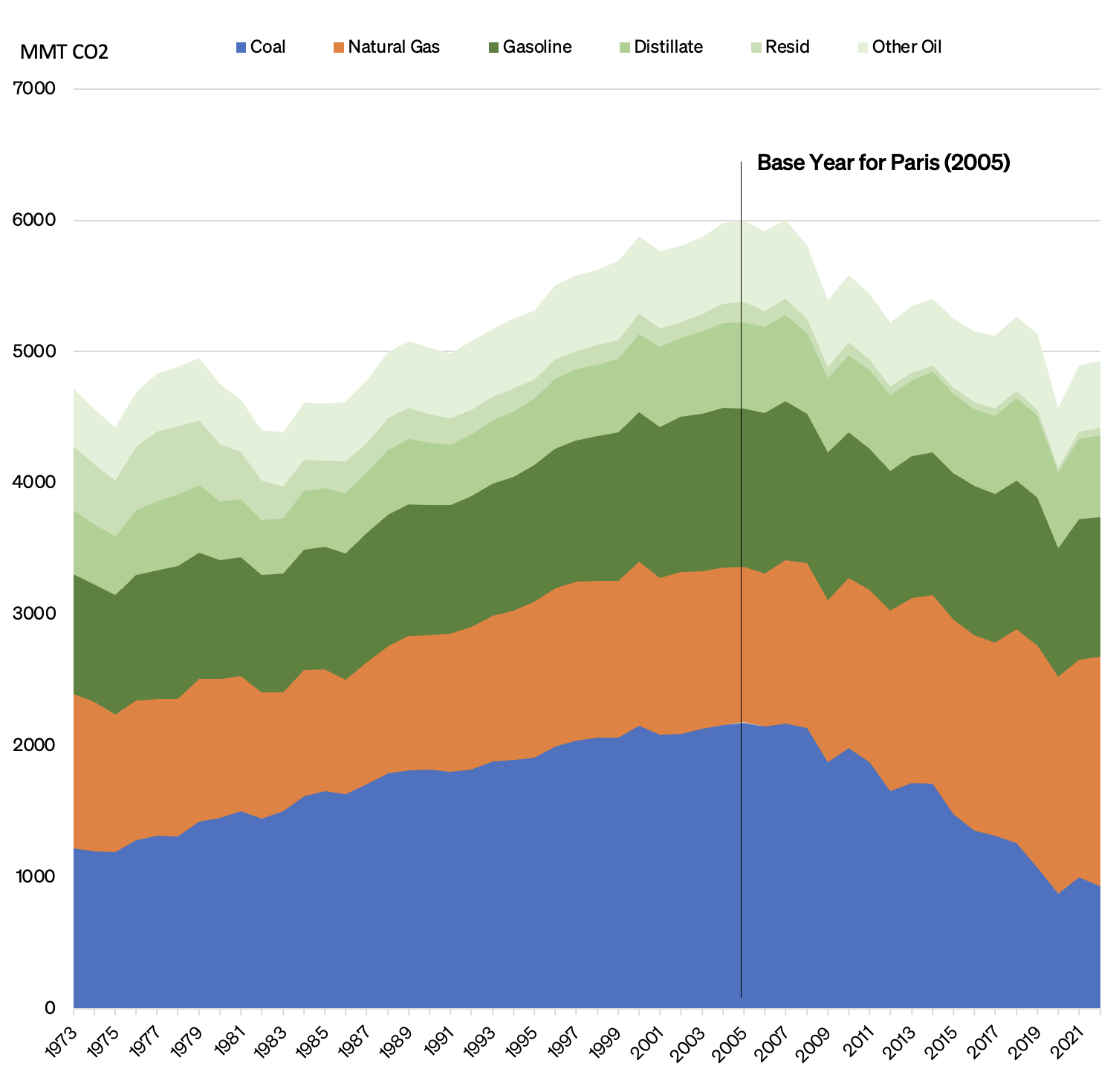
Note: Gasoline and distillate exclude biofuels.
The marked reversal of energy-related CO2 emissions can be explained by both a substantial slowdown in overall U.S. energy demand as well as a significant change in the mix of energy sources.
Overall U.S. energy demand has slowed markedly.[11] Indeed, EIA data shows that U.S. energy demand has declined by 3% since 2005 (an annual decrease of 0.2%), after rising by 19% between 1990 and 2005 (a 1.2% annual increase). In turn, much of the slowdown in U.S. energy demand can be explained by slower economic growth: The U.S. economy grew by an inflation-adjusted average of 3.2% annually from 1990–2005, but by only 1.8% annually from 2005–22. In addition, energy consumed per unit of real GDP declined by 29% over 2005–22, a result of efficiency improvements and structural change in the macroeconomy.[12]On average, oil prices have also been significantly higher since 2005: Inflation-adjusted oil prices averaged roughly $40 per barrel during 1990–2005 and more than doubled to average $95 during 2005–22.[13]
In addition, the mix of fuels consumed by the U.S. economy shifted dramatically, driven by the “shale revolution” as well as rapid growth in renewable energy (the latter, in turn, driven both by policy support and rapidly falling costs). Since 2005, the U.S. has had the second-largest growth of domestic energy supply in the world, behind only China.[14] The U.S. has seen the largest absolute growth of 1) oil production, with an increase of 11 million barrels per day in 2005–22, accounting for an astounding 90% of global growth; 2) natural gas, with 40% of global growth; and 3) biofuels, with 35% of global growth. It has also had the second-largest growth of wind and solar generation, again behind only China.
Figure 5 — US Energy Consumption, 1973-2022
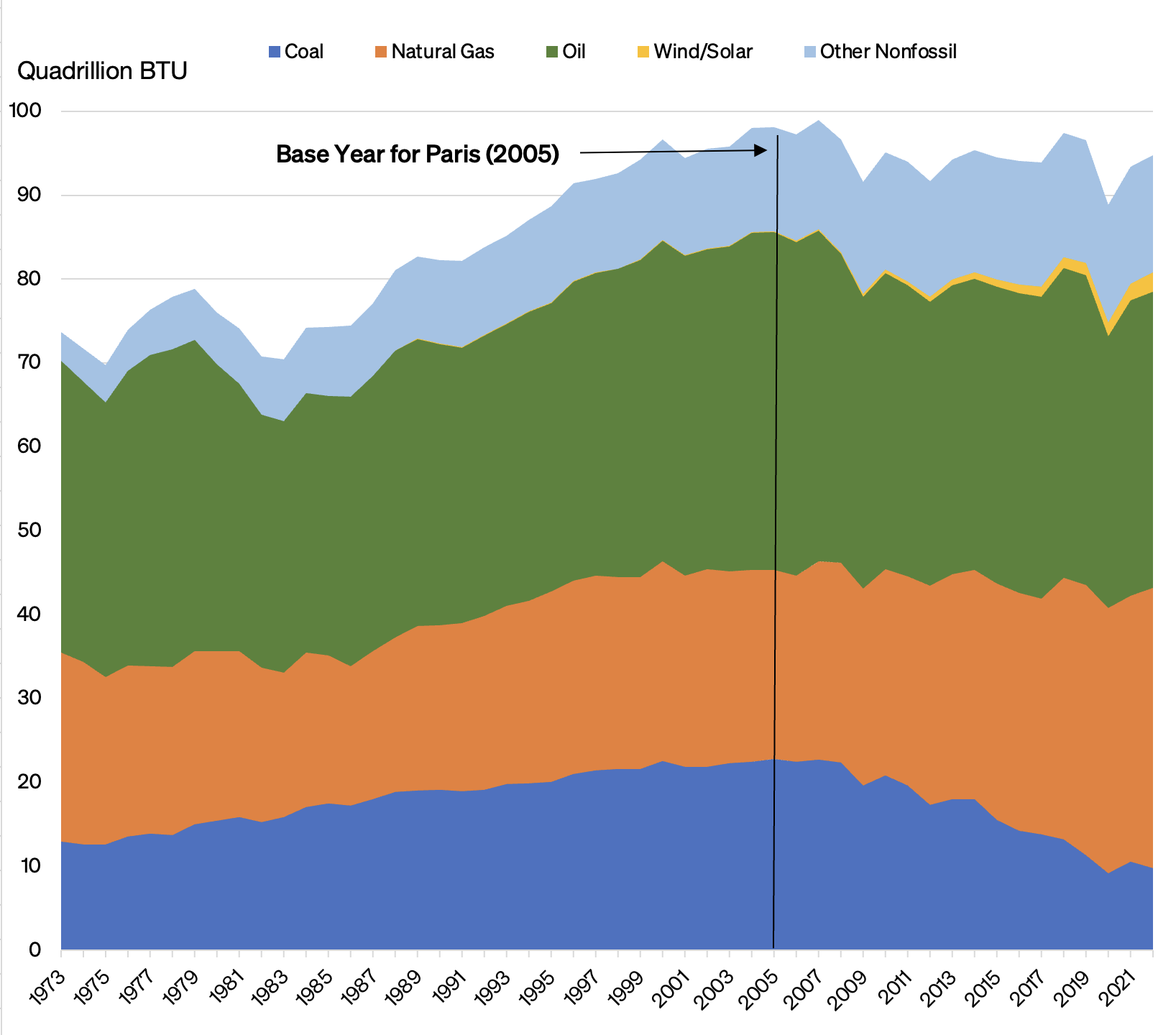
A Global Energy Super Power, But Still Part of Global Markets
Strong domestic supply growth has made the U.S. self-sufficient, in net terms, in overall energy for the first time since the 1950s, and a net exporter of oil, natural gas, and coal. Rapid growth in domestic supply — particularly in oil, natural gas, and renewables — has dramatically reduced import dependence. In 2005, coincidentally the base year for Paris Agreement emission reduction commitments, U.S. net oil imports peaked at 60% of domestic oil consumption. By 2020, surging domestic production had made the U.S. a small net oil exporter. The U.S. became a net natural gas exporter in 2017, and recently became the world’s largest liquefied natural gas (LNG) exporter.
But energy self-sufficiency has not made the U.S. energy-independent, particularly when it comes to oil. The fact that the U.S. is a small net oil exporter masks the fact that it remains deeply connected with the global marketplace. In 2022, the U.S. consumed roughly 20 million barrels per day (Mb/d), while net exports reached 1.2 Mb/d. But due to a mismatch between the quality of domestic oil production and the configuration of U.S. refineries, as well as the complexity of managing a continental domestic market, total U.S. oil trade of nearly 18 Mb/d was nearly as large as domestic demand. While the U.S. exported 9.5 Mb/d of crude oil and refined products in 2022, the country also imported 8.3 Mb/d, making it the second-largest gross oil importer in the world behind China. Moreover, the U.S. remains a net importer of crude oil, but the world’s largest net exporter of refined products. The result is that domestic prices continue to move in concert with global prices, and that U.S. consumers remain vulnerable to global supply-demand developments.[15]
The U.S. and its allies have reaped significant economic and geopolitical benefits from growing U.S. fossil energy exports, especially at a time when global energy prices have increased and the Russian invasion of Ukraine has renewed energy security concerns. However, this growth has been, at times, in tension with U.S. and global climate aspirations. As with other energy exporters, the U.S. NDC is based on emissions from national energy consumption. With U.S. fossil energy exports projected to continue increasing by the EIA, the carbon content of U.S. fossil energy exports could become more important as the nation seeks to advance domestic and global action to address climate change, even if the economic and energy security benefits of being a net fossil energy exporter remain.[16]
Changes by Fuel
As a result of these forces, domestic coal consumption declined in absolute terms and lost significant market share in the U.S. energy mix, falling from 23% of domestic energy use in 2005 to just 10% last year.[17] In absolute terms, and excepting the pandemic-related collapse in 2020, U.S. coal consumption last year was the lowest since 1961. Oil has remained the single largest energy source for the U.S. and global economy, but also lost market share in the domestic energy mix — falling from 41% of domestic energy demand to 37%.
Meanwhile, domestic consumption of natural gas and renewable energy forms rose rapidly. Natural gas is the second-largest fuel in the domestic energy mix, having grown from 23% of energy demand in 2005 to 35% last year. Finally, renewable energy as a group (including biomass, wind/solar, hydroelectricity and geothermal) has grown from 5% of the domestic energy mix to 9%: Bioenergy and wind power each have gained 2 percentage points of market share in the domestic energy mix, and solar energy has gained 1 percentage point.
Figure 6 — US Energy Consumption by Type, 2005
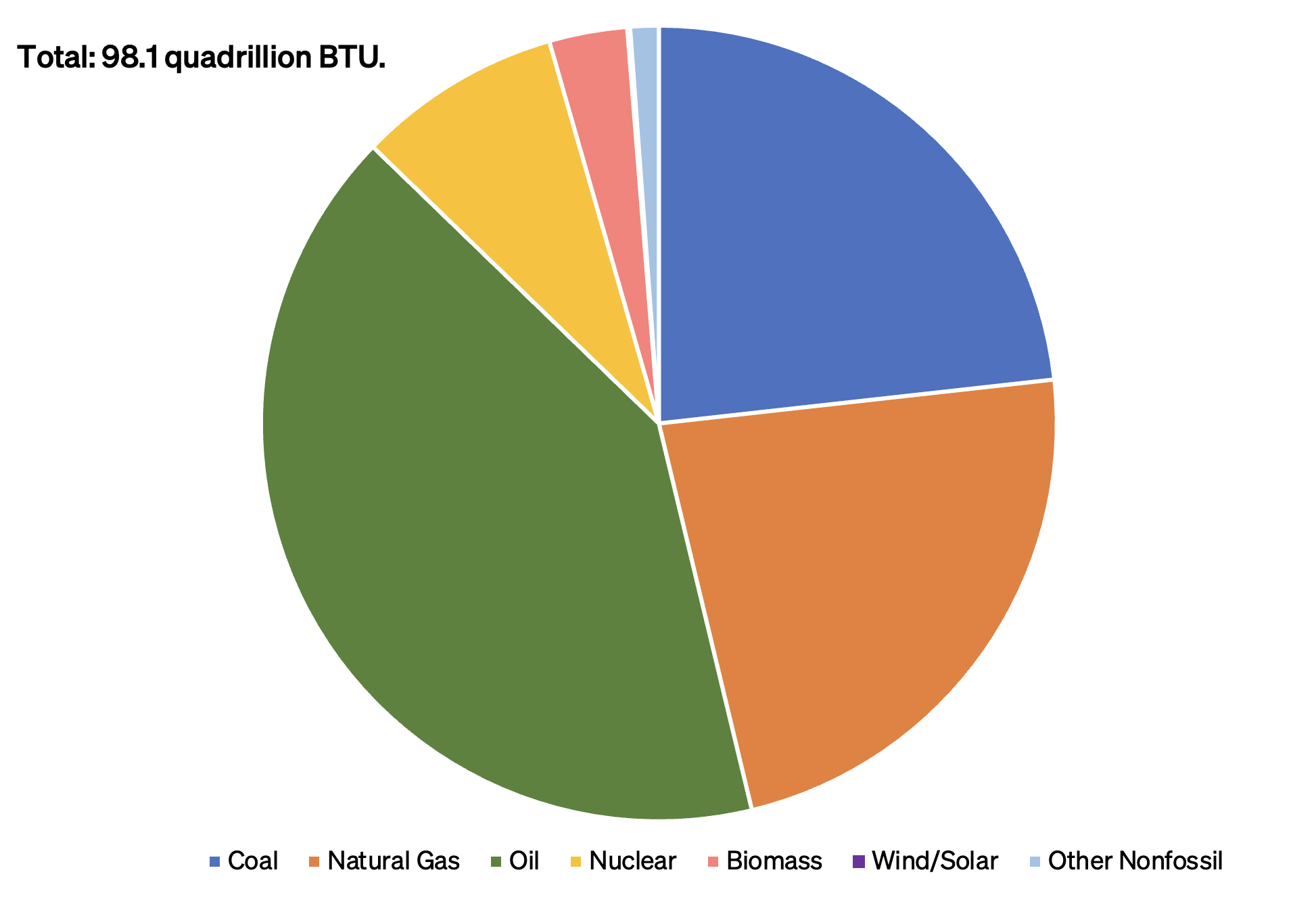
Note: BTU = British thermal units.
Figure 7 — US Energy Consumption by Type, 2022
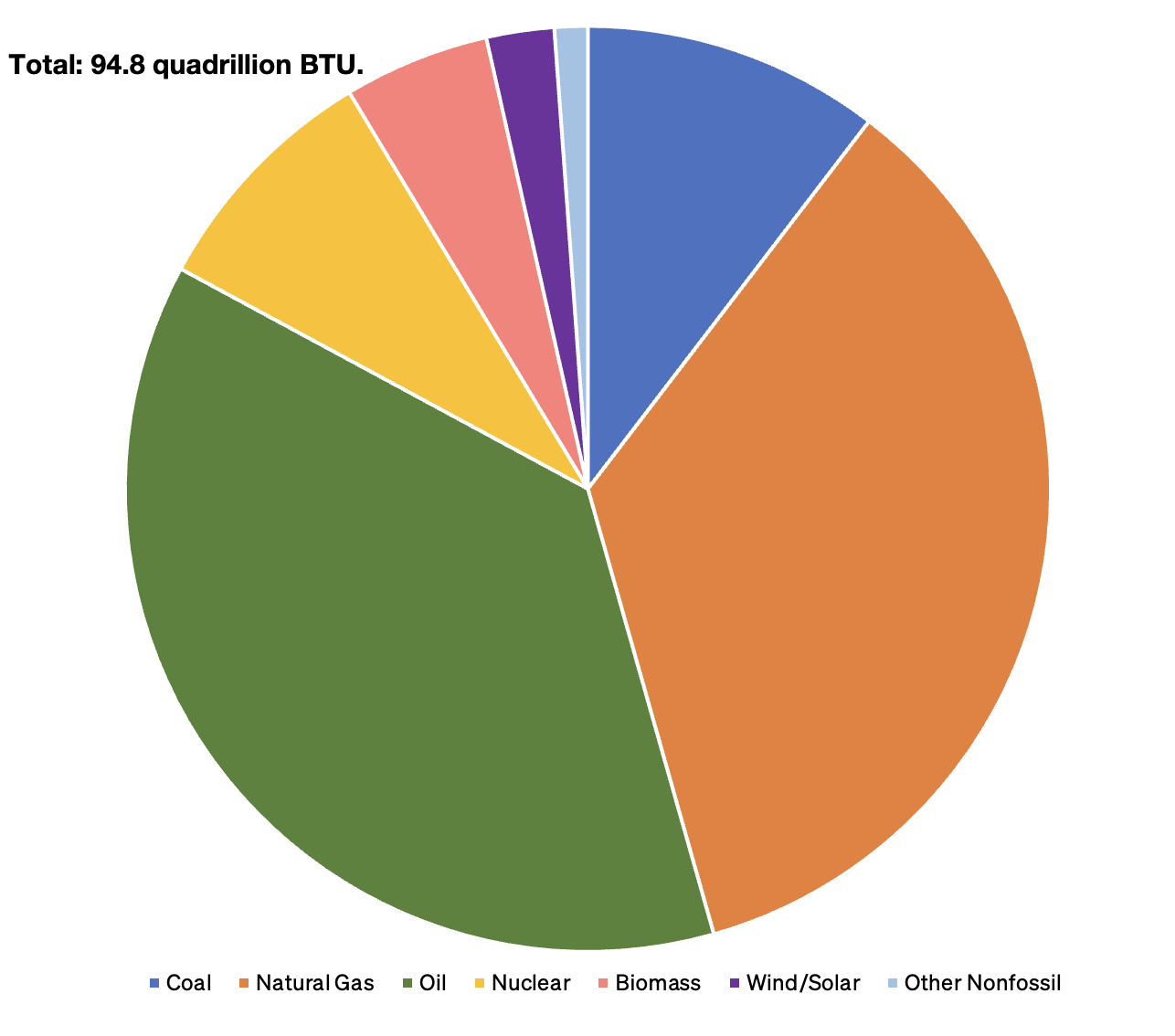
Note: BTU = British thermal units.
The trend in U.S. CO2 emissions from fossil energy combustion through 2022 based on EIA data reflects these developments, with emissions declining by nearly 18% since 2005 (17.8% to be exact, or 1068 MMT). Emissions from coal combustion — which declined by 57%, or 1245 MMT — account for more than 100% of the decline. Emissions from oil combustion also declined, by 14.6%, or 383 MMT, while significant growth in emissions from natural gas combustion of 47%, or 561 MMT, partially offset the declines for coal and oil. Among oil products, emissions from the largest fuel, gasoline, saw the largest absolute decline — falling by 12%, or 140 MMT — but other refined products also made significant contributions due to much larger percentage declines: Residual fuel oil declined by 64%, or 102 MMT, petroleum coke declined by 48%, or 53 MMT, and distillate declined by 5%, or 33 MMT, largely due to a sharp drop in the use of heating oil in the residential sector.
Changes by Sector
Given the sharp decline in coal use and the more modest decline in oil use, it is not surprising that power generation and transport accounted for the heavy majority of the decline in energy-related U.S. CO2 emissions. Power sector emissions — which fell by 36%, or 872 MMT — accounted for 82% of the overall decline, with a sharp drop in coal use partly offset by strong natural gas growth. Meanwhile, transport, which fell by 7%, or 138 MMT, accounted for 13% of the decline.
Smaller contributions were seen from the industrial and residential sectors — which declined by 6% or 61 MMT and 7% or 27 MMT, respectively — partially offset by a small increase in emissions from the commercial sector, of 13% or 29 MMT. With the decline in emissions from power generation, transport became the leading sector for energy-related CO2 emissions in 2017. Last year, transport accounted for 37% of energy-related CO2 emissions, followed the power generation (31%), industry (19%), and residential/commercial (7% and 5%, respectively) sectors.
Figure 8 — Change in US Primary Energy Consumption by Sector, 2005-22
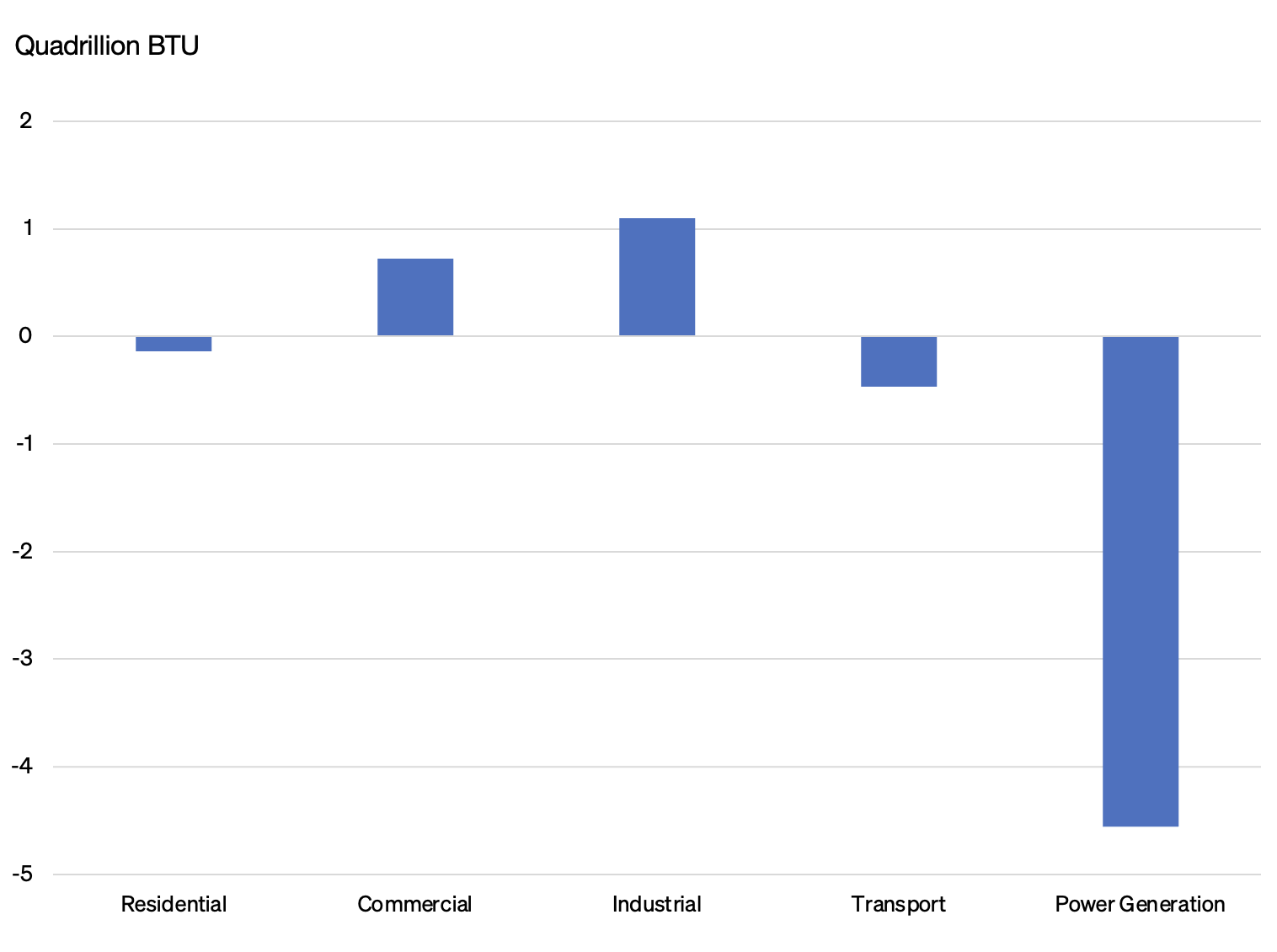
Note: Sectoral figures do not include electricity use and related transmission losses.
Within the power sector, CO2 emissions fell by 36% after 2005. As with the U.S. economy more broadly, slower demand, increased efficiency, and changes in the fuel mix all played a role. Power generation slowed significantly, rising by 1.9% annually from 1990-2005, but by just 0.3% annually since then. And greater efficiency in generation meant that energy consumed in power generation slowed even more dramatically, from an average annual increase of 1.9% from 1990–2005 to an average annual decline of 0.8% since then.
In addition, the mix of fuels used in generating electricity shifted dramatically. In a nutshell: Coal has been pushed out by natural gas and renewables, with a much smaller contribution from lower oil use in power generation. Emissions from coal use in power generation fell by 57% or 1136 MMT, while oil-related emissions fell by 79% or 78 MMT; natural gas-related emissions in power generation more than doubled, rising by 342 MMT. Nonfossil energy sources, including nuclear energy, wind, hydro, solar, and other renewables, grew their share of total electricity output from 29% to 40%. Essentially all of this was from wind and solar, which grew by a combined 562 gigawatt-hours (GWh), or 3061%. The combined market share of wind and solar grew from 0.5% of total power generation in 2005 to 14% in 2022.
But the startling growth of wind and solar generation accounted for less than half of coal’s decline (the decline in coal-fired generation was 1183 GWh, or 59%). The bigger contributor — regarding power generation, not emissions — was natural gas: Gas-fired generation grew by a massive 923 GWh (122%) since 2005.[18]
Within the transport sector, oil accounted for more than 100% of the decline in CO2 emissions, falling by 9% (175 MMT). This decline was partly offset by a rise in emissions from natural gas use in transportation, which more than doubled, rising by 112% or 37 MMT, largely due to its growing use as pipeline fuel. Gasoline-related emissions, which fell by 13%, or 154 MMT, accounted for a heavy majority (88%) of the decline in oil-related CO2 emissions in transport. Refined products used for off-road transport provided relatively small contributions: Residual fuel oil (largely for shipping) fell by 21% (13 MMT), and jet fuel fell by 7% (18 MMT), largely since the pandemic. These declines were partly offset by increased emissions from distillate (diesel) combustion (an increase of 3%, or 13 MMT).
What explains the decline in gasoline-related CO2 emissions since 2005? As was the case with overall energy demand, transport sector energy demand slowed significantly in recent years, growing by 1.6% annually for 1990–2005 but falling by 0.1% annually for 2005–22. And similarly, as was the case more broadly in the U.S. economy, greater efficiency played a role in slowing energy use in the transport sector, as fuel efficiency (CAFE) standards gradually began to increase in the 2000s.[19] As a result, U.S. vehicle miles traveled (VMT) rose by 6% over this period, even as transport sector energy use declined slightly.[20] Note: Before the pandemic, light-duty vehicles accounted for about 90% of total U.S. VMT.[21]
Additionally, oil’s share of energy consumed in the transport sector also declined, from 96% of total energy use in 2005 to 89% in 2022. This was largely due to rapid growth of biofuels — largely ethanol blended with gasoline, but increasingly including biodiesel — which expanded their share of transport sector energy use from 1% to 6% (Table 1). While electric vehicles are growing rapidly, they have not yet begun to materially impact the sectoral energy mix, with electricity — including transmission losses — accounting for about 0.2% of sectoral energy use in 2022, similar to the share in 2005.
Table 1 — The Growing Role of Biofuels in the US Transport Mix

Note: EIA distillate is largely diesel fuel but also includes a small amount of home heating oil.
Going Forward: A Narrow Path for Emissions to Meet US 2025 Target
Based on the EPA’s inventory of data through 2021, net U.S. GHG emissions would need to fall by approximately 11% between 2021 and 2025 to meet the lower boundary (26%) of the country’s Paris commitment — that is, by roughly 3% annually, nearly triple the annual average rate of decline since 2005 (1.2%).
Moreover, as mentioned above, the more recent EIA data shows that CO2 emissions from energy use — which, again, account for more than three-quarters of gross U.S. GHG emissions — rose slightly (0.7%) in 2022. So far this year, EIA data shows that CO2 emissions from energy use have declined fairly substantially: Through July, the year-on-year decline was 4.1%, driven by a 21% decline in coal emissions. The monthly declines were strongest early this year due to mild winter weather. For 2023 as a whole, the EIA is currently projecting that energy-related CO2 emissions will fall by 3.1%.[22]
The EIA also projects that U.S. energy-related CO2 emissions will fall by 0.7% in 2024 and by 2.4% in 2025.[23] While this continues, and indeed, accelerates the significant rate of change seen since 2005, it would nonetheless leave the U.S. short of its Paris commitment reductions without a massive acceleration in the decline of other U.S. GHG emissions. Note that the EIA reference case includes analysis of the impacts of the 2022 Inflation Reduction Act and earlier relevant legislation, such as the 2021 Infrastructure Investment and Jobs Act.
What Would It Take to Meet the Paris Projections?
Figure 9 — A Challenging Pathway to Paris: US Net Emissions
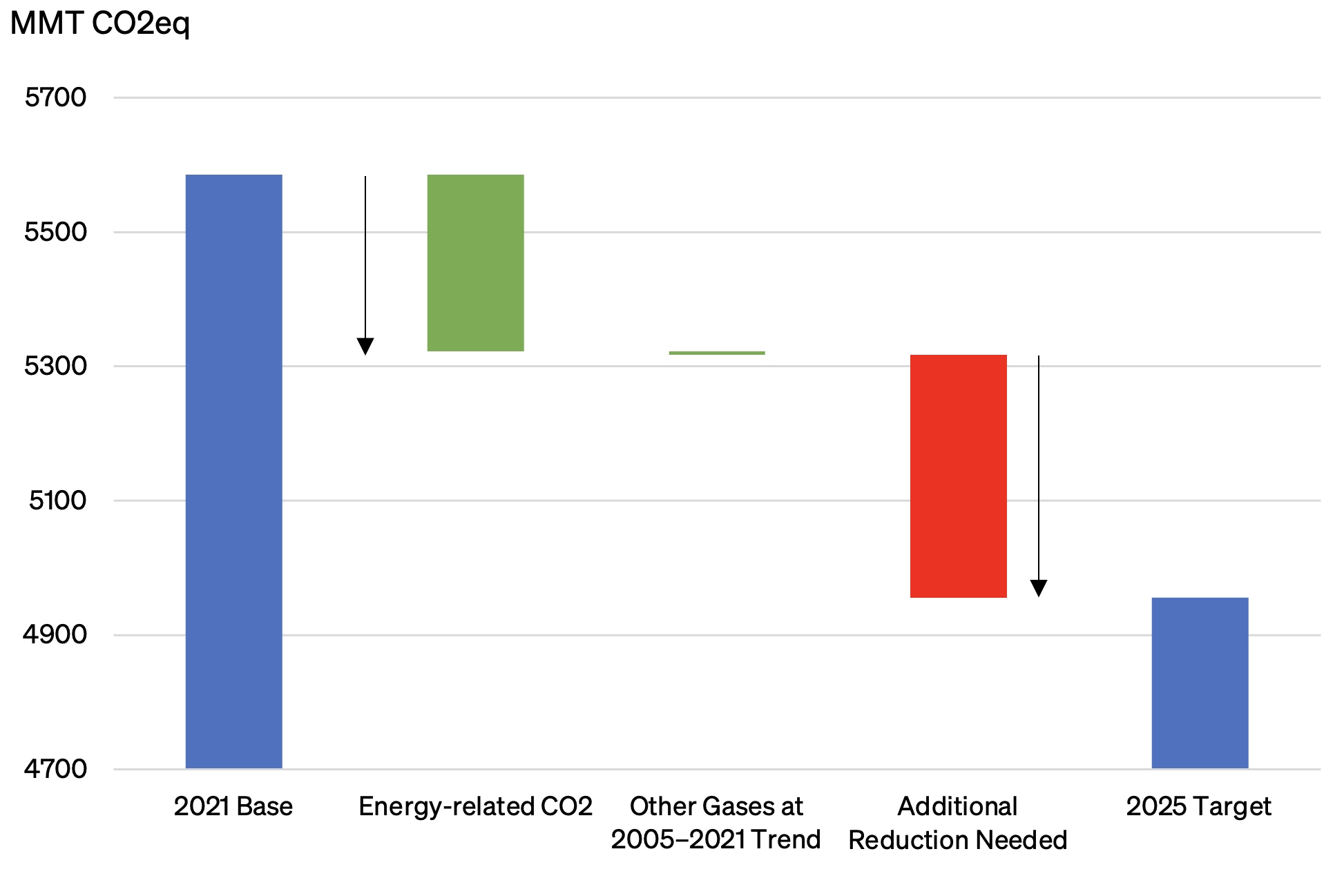
Note: A hypothetical scenario based on the EIA’s outlook for energy-related CO2 emissions and all other GHG gases following their 2005–21 trend from the EPA inventory.
Admittedly, the EIA’s projections are made in the face of tremendous uncertainties that color the degree of confidence we can have in them. Over the relatively short time period through 2025, the path for overall energy demand (and emissions) will depend on factors as diverse as GDP growth, weather patterns, and of course energy prices. Beyond that, key issues will include:
- Power. We can expect continued rapid growth in wind and solar generation and in the displacement of coal in power generation. Key questions will include the pace of overall power demand growth and the need for natural gas in power generation. After years of rapid growth, the EIA’s short-term outlook projects the growth of natural gas use in power generation to slow significantly, while the agency’s long-term outlook shows a significant decline between now and 2025, with variables as diverse as the strength of overall power demand and renewables growth coming into play. The EIA also expects the rapid growth of electric vehicles, or EVs, is unlikely to add materially to power demand through 2025. Other observers, however, note a range of factors that could support stronger-than-expected growth in electricity demand.[24] In turn, uncertainty over the pace of power demand growth — and the potential need for natural gas to help balance the variability of wind and solar generation — means that prospects for natural gas (and gas-fired emissions) are an additional uncertainty. Finally, there is limited scope for further reduction in oil in power generation, since oil accounted for just 0.6% of power generation last year.
- Transport. Both EVs and tighter fuel efficiency standards — we are in the midst of a rapid increase in CAFE standards — appear to be long-term issues with limited near-term impact, though the impact of tighter fuel efficiency standards already seen in recent years will continue to weigh on demand as those model years slowly grow their share of the overall vehicle fleet. The EIA expects limited near-term scope for more biofuels to displace oil in transportation.[25]
- The industrial and residential/commercial sectors. GDP and weather patterns are likely to be the key drivers of near-term energy use. The need to turn over capital stock in both industrial equipment and buildings makes it difficult to expect significant changes in next few years. Factors that may lead to large long-term changes in energy use —but which are unlikely to move the needle by 2025 — include efforts to build up hydrogen capacity, displace natural gas with heat pumps, improve building insulation, and boost the efficiency of HVAC systems.
Conclusion
The U.S. has made substantial progress in reducing its net GHG emissions since 2005 — almost entirely due to falling energy-related CO2 emissions. Stagnating overall energy demand and the rapid displacement of coal in power generation by natural gas and renewable energy have been the key energy drivers, supplemented by lower oil demand in transportation. An evaluation of the near-term prospects for U.S. energy demand suggests that, while continued reductions are likely and could indeed accelerate, it will be difficult for the U.S. to meet its 2025 Paris commitment of reducing net GHG emissions by 26–28% without a greater contribution from other U.S. GHGs than we have seen to date.
For the energy sector, official projections suggest the decline in coal will slow relative to the rapid displacement seen since 2005. Upside risks to power demand could bolster demand for natural gas and boost gas-related CO2 emissions. Similarly, biofuels are unlikely to displace oil in transport to the same degree they have done since 2005. In the longer term, growth in EVs and investment in new energy technologies and greater fuel efficiency hold tremendous promise, but they are unlikely to materially rebalance the U.S. energy system in the near term. As we saw during the COVID-19 pandemic, a recession would slow U.S. energy demand growth and spur lower CO2 emissions, but at the cost of lost jobs and lower standards of living.
Notes
[1] United Nations Framework Convention on Climate Change (UNFCC), “Warsaw Outcomes,” https://unfccc.int/process/conferences/the-big-picture/milestones/outcomes-of-the-warsaw-conference.
[2] United Nations (UN), “The Paris Agreement,” https://www.un.org/en/climatechange/paris-agreement.
[3] UNFCC, “The United States’ Nationally Determined Contribution,” https://unfccc.int/sites/default/files/NDC/2022-06/United%20States%20NDC%20April%2021%202021%20Final.pdf.
[4] Michael D. Shear, “Trump Will Withdraw U.S. From Paris Climate Agreement,” New York Times, June 1, 2017, https://www.nytimes.com/2017/06/01/climate/trump-paris-climate-agreement.html; Matt McGrath, “Climate Change: US Formally Withdraws From Paris Agreement,” BBC, November 4, 2020, https://www.bbc.com/news/science-environment-54797743; and “The United States Officially Rejoins the Paris Agreement,” press statement, February 19, 2021, https://www.state.gov/the-united-states-officially-rejoins-the-paris-agreement/#:~:text=On%20January%2020%2C%20on%20his,becomes%20a%20Party%20again%20today.
[5] U.S. Environmental Protection Agency (EPA), “Inventory of U.S. Greenhouse Gas Emissions and Sinks,” https://www.epa.gov/ghgemissions/inventory-us-greenhouse-gas-emissions-and-sinks.
[6] UNFCC, “UN Climate Change Conference – United Arab Emirates Nov/Dec 2023,” https://unfccc.int/cop28.
[7] The convention in measuring the climatological impact of greenhouse gases is to express their impact relative or “equivalent” to CO2.
[8] Remaining gross emissions, on the basis of CO2 equivalence, were from methane (12.5%), nitrous oxide (6.4%), and fluorinated gases (3%). This report does not examine methane emissions in more detail, although about 40% of U.S. methane emissions come from the energy sector, with the remainder coming from agriculture and waste.
[9] U.S. Energy Information Administration (EIA), “Table 11.1: Carbon Dioxide Emissions From Energy Consumption by Source,” in Monthly Energy Review, accessed November 8, 2023, https://www.eia.gov/totalenergy/data/monthly/index.php. Note that the Monthly Energy Review also includes annual data; while the EIA’s CO2 emissions data does not exactly match the EPA’s data, in aggregate the two differ by just 1% for 2021.
[10] The EPA inventory shows that energy-related CO2 emissions fell by just over 18% between 2005 and 2021. Note that the EIA excludes biofuels from oil-related CO2 calculations even though it includes biofuels in its oil consumption data.
[11] EIA, “Table 1.1: Primary Energy Overview,” in Monthly Energy Review, accessed November 8, 2023, https://www.eia.gov/totalenergy/data/browser/index.php?tbl=T01.01#/?f=M&start=200001.
[12] EIA, “Table 1.7: Primary Energy Consumption, Energy Expenditures, and Carbon Dioxide Emissions Indicators,” in Monthly Energy Review, accessed November 8, 2023, https://www.eia.gov/totalenergy/data/monthly/pdf/sec1_19.pdf.
[13] Inflation-adjusted average consumer prices for natural gas and electricity did not change materially between the two periods.
[14] For U.S. data, see EIA, “Table 1.2: Primary Energy Production by Source,” in Monthly Energy Review, accessed November 8, 2023, https://www.eia.gov/totalenergy/data/browser/index.php?tbl=T01.02#/?f=M&start=200001. Author calculations for global energy production context based on data from the Energy Institute (“2023 Energy Institute Statistical Review of World Energy,” https://www.energyinst.org/statistical-review).
[15] EIA, Monthly Energy Review, accessed November 8, 2023, https://www.eia.gov/totalenergy/data/monthly/previous.php.
[16] EIA, “Table 1. Total Energy Supply, Disposition, and Price Summary,” in Annual Energy Outlook 2023, accessed November 8, 2023, https://www.eia.gov/outlooks/aeo/data/browser/#/?id=1-AEO2023&cases=ref2023&sourcekey=0.
[17] EIA, Monthly Energy Review.
[18] Oil use in power generation also continued its long-term decline, falling by 81% or 99 GWh.
[19] U.S. Department of Energy (DOE), “Vehicle Fuel Efficiency (CAFE) Requirements by Year,” Alternative Fuels Data Center, accessed November 8, 2023, https://afdc.energy.gov/data/10562.
[20] U.S. Department of Transportation (DOT), “Figure 1 - Moving 12-Month Total on All Roads,” in December 2022 Traffic Volume Trends, Federal Highway Administration, accessed November 8, 2023, https://www.fhwa.dot.gov/policyinformation/travel_monitoring/22dectvt/figure1.cfm.
[21] DOT, “Vehicle Miles Traveled by Highway Category and Vehicle Type,” Bureau of Transportation Statistics, accessed November 8, 2023, https://www.bts.gov/browse-statistical-products-and-data/freight-facts-and-figures/vehicle-miles-traveled-highway.
[22] EIA, “Table 9a: U.S. Macroeconomic Indicators and CO2 Emissions,” Short Term Energy Outlook Data Browser, accessed November 8, 2023, https://www.eia.gov/outlooks/steo/data/browser/#/?v=5.
[23] We use the EIA’s short-term outlook (STEO) for projections through 2024 and its long-term annual energy outlook (AEO) for 2025. The two projections report slightly different baselines for U.S. energy-related CO2 emissions and different near-term growth rates. For example, the STEO dataset shows 2022 emissions of 4939 MMT, while the AEO dataset has emissions of 4854 MMT. The STEO projects U.S. emissions to fall by 3.1% this year and by 0.7% in 2024; the AEO projects declines of 2.9% and 1.1%, respectively. Data accessed November 8, 2023.
[24] See, Jennifer Hiller, “Electricity Use Booms in Texas, a Harbinger for the Country”, Wall Street Journal, November 13, 2023. https://www.wsj.com/business/energy-oil/texas-size-electricity-demand-is-the-grids-big-future-37f0d7ca
[25] EIA, Annual Energy Outlook.
This material may be quoted or reproduced without prior permission, provided appropriate credit is given to the author and Rice University’s Baker Institute for Public Policy. The views expressed herein are those of the individual author(s), and do not necessarily represent the views of Rice University’s Baker Institute for Public Policy.



